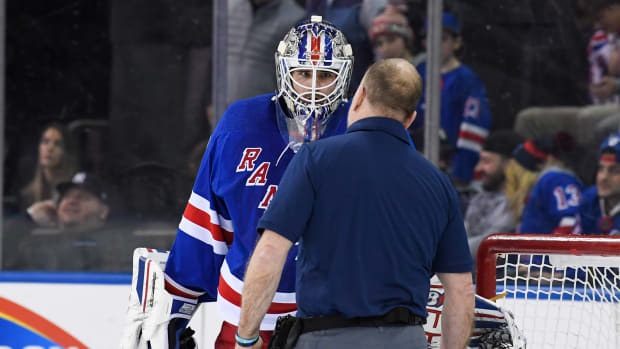As we’ve seen in these Stanley Cup Playoffs, goaltenders, when on their game, can be the most dominant, and valuable players on the ice. So, you expect them to be the crown jewels of the sport, and their health to be a major priority for their employers.
Those health concerns could be seen in the wake of Sunday’s 3-2 Tampa Bay Lightning win over the New York Rangers. The Blueshirts were not pleased by the crowding that took place near and around superstar Rangers goalie Igor Shesterkin, and they made that clear to the media after the game.
“I don’t like it,” Rangers head coach Gerard Gallant told the New York Post of the uptick in physical play close to Shesterkin. “I don’t think it’s a big part of (the game) and hopefully when we talk to the (NHL) supervisor tomorrow, they’ll take care of some of that, because it wasn’t right”.
The supervisor Gallant was referring to is Kay Whitmore, a former NHL goalie and longtime goaltending league expert on the position. Whitmore is the league’s official goaltending supervisor. What happens to goalies usually affects Whitmore in one aspect or another, and the idea that opposing players are going over the line when it comes to goalie safety will surely come to his attention now, if it hasn’t already. But the reality is the league needs a clearer, more black-and-white situation.
Why? Well, while there’s a place for nuance and the individual circumstances of any one particular goaltender-related on-ice incident, the bigger picture must be sent to NHL skaters that reckless play that has an effect, sometimes directly, on a goalie’s well-being will not be tolerated. Just as the NFL protects its top, often-times most-marketable athletes with rules that shield quarterbacks from grievous history, so too must hockey’s top league enforce legitimate protection for netminders.
There is a grey area on collisions that take out goalies. The most recent one – when Colorado Avalanche star center Nazem Kadri collided with St. Louis Blues No. 1 goalie Jordan Binnington in their second-round playoff series – was not a clear instance where the opposition, Kadri, in this case, was steered into Binnington by Blues D-man Calle Rosen. Could Kadri have pulled up? Possibly, But this is part of the problem with the ever-increasing speed of the sport; Kadri has been coached to go full-speed toward the other end, and when he was taken out of his skating trajectory, it was too easy for him to be shoved aside and have his momentum carry into Binnington.
All of which is to say that, while the league’s Department of Player Safety department could’ve suspended Kadri for the Binnington hit, it also makes sense, in this case, to include Rosen in the overall punishment – for “contributing to a reckless hit”, or whatever label you want to give it. That would give defensemen in future more reason to steer an opponent away from the defenseman’s goalie. It wouldn’t stop all goalie collisions from happening, but even if it stops a few, that kind of rule would be helpful in protecting goalies as a group.
If that sounds too foreign to you, rest assured the status quo is not an option. Goalies have been sidelined this season at an alarmingly increased rate, and while goalie collisions aren’t the chief driver of that spike in injury, any goalie saved from a collision is a goalie more likely to stay healthy.
The NHL tweaks and invents new rules quite often. It usually takes an impetus from a slew of on-ice events to get the league to change, but it’s fair to say we’re at that point with NHL goalie safety. Binnington’s injury-related absence helped prevent the Blues from beating the Avs to make the Western Conference Final. Ideally, the Avalanche and any other team should want to beat their opponent while they’re at full strength. The sooner we get goalie protections increased, the more likely that will be.



